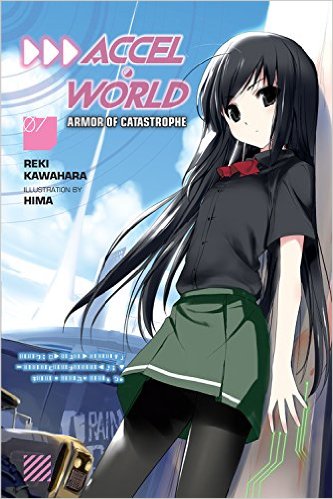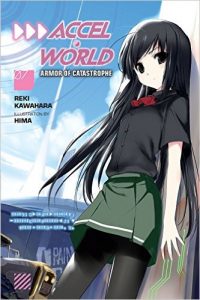By Reki Kawahara and Hima. Released in Japan by ASCII Mediaworks. Released in North America by Yen On. Translated by Jocelyne Allen.
Accel World is about a group of elementary and junior high school students fighting battles to the death, and the novels are not afraid to show you the emotional fallout from such a situation. In fact, the first quarter of this book is devoted to a giant flashback to several years prior (when the best you could do is Level 5), where a young couple who have fallen in love in the Brain Burst world (despite not knowing who their real life identities are – oh, and she’s dying in real life as well) discover one of the seven Big Powerups in the game, and as a result are quickly turned on by their supposed friends and fellow players. It’s played for maximum tragedy and drama, and helps to explain why the Disaster Armor currently infecting Haru has a mind of its own.
And these are kids, even if they supposedly have more emotional maturity from all the time they spend in accelerated time. Nowhere is that more clear than with the confrontation Haru has with Takumu at the end of the book. Takumu’s jealousy of Haru was, of course, part of the plot of the very first volume, and it’s actually good to see that it did not magically go away, because those sorts of things don’t. It’s also not being helped by the new ISS pseudo-Disaster program, which is corrupting him so it’s hard to tell if these are his own thoughts or not. But you also see it with Haru, who is also still just a kid, and whose desire to punch hope into Takumu somehow is shown in the end to be just as foolish and short-sighted in a world where nothing is ever quite as easy as you expect. Which of course, means this is not a two-book series, but an arc, and we’ll see what happens next time.
Elsewhere in the book, Haru and Utai manage to at least get closer to escaping from the Imperial Palace world they’re still stuck in in the Unlimited section, helped along by a mysterious samurai-type who happens to have been in the section all along but refuses to tell them how he got there. It’s fairly clear this young boy is supposed to be a member of the Imperial Family (which explains why he’s there – he lives there), but Kawahara is being very coy about it for reasons that are also fairly clear. And Haru and Kuroyukihime get some nice shippy moments, much to the frustration of Chiyuri and Fuko, which leads to probably the book’s funniest moment (and also makes me think that Fuko is more interested in Kuroyukihime than Haru). And of course Haru remains marked for death, both from the Kings and from a group that has put a bounty on his head, as we realize that the flashback we see at the start of the book may come full circle.
This is mostly a setup book that will likely pay off with big fights in the next volume, but as always it’s eminently readable, and for once the cover is not something you have to hide from the outside world. And there should be less of a wait for the next one – the series seems to be shifting to four times a year.

